ECB Calls Bernanke’s Bluff on Defending the US Dollar
Interest-Rates / US Interest Rates Jun 13, 2008 - 03:45 AM GMTBy: Gary_Dorsch

 A new member of the British Parliament once solicited the advice of Benjamin Disraeli, the nineteenth century British prime minister, on whether he should speak up on a controversial issue. “Do you have anything to say that has not already been said?” Disraeli asked him. “No,” the man conceded. “I just want the people whom I represent, and the members of Parliament to know that I participated in the debate.”
A new member of the British Parliament once solicited the advice of Benjamin Disraeli, the nineteenth century British prime minister, on whether he should speak up on a controversial issue. “Do you have anything to say that has not already been said?” Disraeli asked him. “No,” the man conceded. “I just want the people whom I represent, and the members of Parliament to know that I participated in the debate.”
Disraeli replied, “Then it's better to remain silent and have people say, I wonder what he's thinking, rather than to speak up, and have people say, I wonder why he spoke.” On June 3rd, the super-dovish Fed chief Benjamin Bernanke, couldn't remain silent any longer, and shocked the global money markets, when he spoke out for the first time, about the need for the Fed to defend the US dollar in the foreign exchange market, before an international television audience.
“The Fed is working with the Treasury to carefully monitor developments in foreign exchange markets,” Bernanke warned. “We are attentive to the changes in the value of the dollar and inflation expectations. The Fed's commitment to price stability is a key factor, insuring that the dollar remains a strong and stable currency. The possibility that commodity prices will continue to rise, and lift inflation expectations are significant risks, that might ultimately become self-confirming,” he said.
A week later, currency traders were left wondering if Bernanke had undergone a brain transplant, and re-programmed as a Bundesbank hawk, when he downplayed the biggest monthly surge in the US jobless rate in 22-years. “The risk that the US economy has entered into a substantial downturn appears to have diminished. The FOMC will strongly resist an erosion of longer-term inflation expectations. There are significant upside risks for inflation through commodities,” Bernanke declared.
Instinctively, foreign currency traders rushed to cover over-extended short positions in the dollar, as yields on the US Treasury's 2-year note, jumped by a startling half-percent in just two-days, to 2.90%, discounting the likelihood of 75-basis points in Fed rate hikes by year's end. Something must have changed, to cause “Helicopter” Ben to suddenly talk about switching gears, from inflating the US money supply at a 17% annualized rate, its fastest in history, to a more prudent course of defending the purchasing power of the dollar.
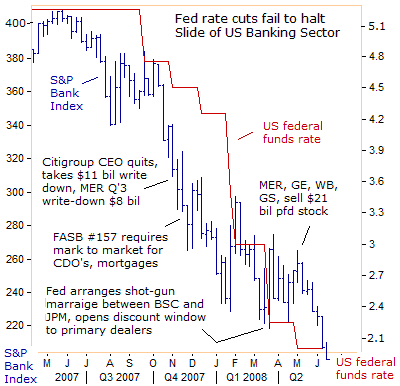
But if “Helicopter” Ben is just bluffing about his determination to defend the US dollar, then it would have been better, had he remained silent last week. Foreign currency traders know the first line of defense for a currency in the $3.2 trillion per day FX market is “jawboning” – or trying to alter trader behavior and psychology with words alone. Initially, “open-mouth operations” are cost-free, and might even achieve the central bank's objective without more expensive remedies.
However, after the initial shock wears-off, if not backed-up by concrete action, “jawboning” begins to lose its potency. If the economic landscape hasn't changed, then before long, quick-trigger traders could test the resolve of the central bank, by the attacking the beleaguered currency. Nowadays, it's the dollar's weakness against the Euro that is helping to elevate the agricultural and crude oil markets, and transmitting a major outbreak of hyper-inflation worldwide.
But with the S&P Banking Sector Index plunging to its lowest level in 12-years, US homes prices sinking at their fastest clip since the Great Depression, and Lehman Brother's LEH.n stock losing 54% of its value in the past four weeks, the Fed's ability to defend the dollar with a tighter monetary policy is very limited. Just last week, Sheila Bair, head of the Federal Deposit Insurance Corp, warned that “weakening real estate markets could take down bigger banks than we have seen in the past,” and would quickly exhaust the FDIC's paltry $58 billion cash reserve.
Furthermore, the US jobless rate jumped a half-percent in May to 5.5%, its highest level in 3-½ years, underscoring the big recessionary risks that the US economy still faces. Some 49,000 jobs were cut from payrolls in May, the fifth straight month of job losses, further sapping consumer confidence, already at a 16-year low. “Weak economic conditions could extend defaults on consumer installment or credit card loans, as well as corporate loan portfolios,” warned Fed deputy Donald Kohn.
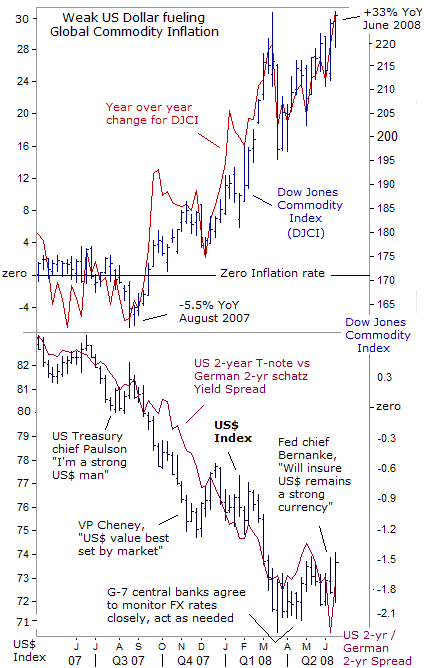
Yet the 2% federal funds rate is pegged far below the inflation rate, and negative interest rates spawn specualtion in the commodities markets. The US dollar remains weak against the Euro, because the yield on the 2-year US Treasury note is roughly -180 basis points below the German 2-year schatz yield. A year ago, the US 2-yr T-note was yielding +60 basis points more than the German schatz.
On June 11th, St. Louis Fed chief James Bullard said the 2% fed funds rate is too low and could fuel inflation, unless the Fed takes action going forward. “The Fed's easing in January and March was very sharp, for insurance against the possibility of a very bad outcome from the financial crisis. The probability of a very bad outcome from the financial crisis is now receding, and we've still got the low level of interest rates. I see inflationary consequences of that going forward, if we don't take action and stay on top of this situation,” Bullard warned.
Since the Fed began its easing campaign in August 2007, the year-over-year increase in the Dow Jones AIG Commodity Index, has soared from a -5.5% to a record +33% today, led by a near doubling in crude oil and grain prices, and pushing the global inflation rate to its highest in three decades. Yet until this month, the Bernanke Fed refused to weigh food and energy prices in its inflation calculations, and instead, solely focused on bailing out Wall Street banks.
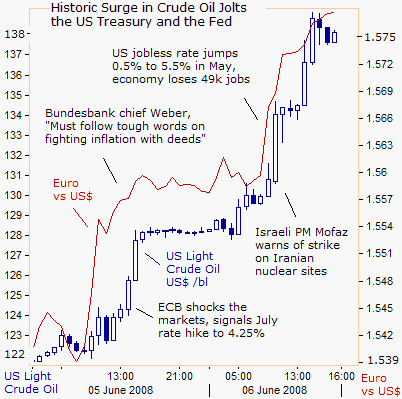
So what cataclysmic event finally forced Mr Bernanke to publicly acknowledge the bankruptcy of his “core inflation” thesis, which strips food and energy out of the Fed's inflation equation? A stunning $16 per barrel surge in crude oil prices, on June 5-6th that knocked the Dow Jones Industrials to a 400-points loss, in a thunderous crash that rattled the US Treasury's “Plunge Protection Team.”
In a perfect storm, crude oil soared to $138 /bl, supported by a 2.5% jump in the Euro to $1.5800, and comments by Israeli deputy prime-minister Shaul Mofaz, who said Israel's patience with Europe's reluctance to impose tough economic sanctions on Iran is wearing thin. Mofaz set the crude oil market ablaze, when he told the Yedioth Ahronoth newspaper, “If Iran continues with its program for developing nuclear weapons, we will attack it. The sanctions are ineffective. Attacking Iran, in order to stop its nuclear plans, will be unavoidable,” he warned.
Mofaz presented a sneak preview of what the crude oil and global stock markets might look like, under the thumb of a nuclear-armed Iran. Whether an attack on Iran or a US naval blockade of its ports, actually happens before President Bush leaves office, is a matter of great debate and speculation. On June 10th, Bush warned, “If you were living in Israel, you'd be a little nervous, if a leader in your neighborhood announced that he'd like to destroy you. And one sure way of achieving that means, is through the development of a nuclear weapon. Therefore, now is the time for all of us to work together to stop Iran,” he said, on his final tour of Europe. The next day, Bush indicated that all options are on the table, in dealing with Iran.
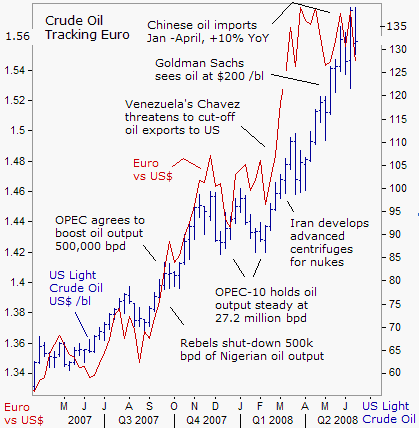
But behind the scenes, the Euro /dollar exchange rate is also magnifying movements in the all-important crude oil market. “I'm very worried about the strength of the dollar. We all know when the dollar weakens, the price of oil goes up,” said Republican presidential candidate John McCain in a June 10th interview on CNBC. It was the first time a key Washington politician acknowledged the link between the weak dollar and the high price of crude oil, and by extension, other related markets that are soaring into the stratosphere, such as coal and corn futures.
Yet as recently as May 28th, Minneapolis Fed chief Gary Stern cautioned against drawing a link between the dollar's decline and lofty energy prices. “I'd be careful about mistaking correlation and causation. Just because energy prices and the dollar seem to move together, doesn't mean that there's causation there. I would point to the rapid growth in China and India that has something to do with this,” he said.
Frederic Mishkin, a close confidant of Bernanke's, was still defending the central bank's practice of ignoring food and energy prices. “Stabilizing core inflation leads to better economic outcomes than stabilizing headline inflation. If central banks raise rates aggressively to counter inflation caused by a sudden rise in oil prices, unemployment will be markedly higher, than if policy-makers set borrowing costs in response to fluctuations in core prices. When inflation expectations are well anchored, the central bank does not need to raise interest rates aggressively to keep inflation under control following an aggregate supply shock,” Mishkin argued.
Indeed, Bernanke appeared to be back-pedaling on his commitment to fight inflation, when he tried to distance the Fed from the use of the commodity prices, to forecast to direction of inflation. “The poor record of commodity futures markets in forecasting the course of prices raises the question of whether policy-makers should continue to use this source of information,” he said on June 9th. It's difficult to combat inflation, if the Fed is blind to the realities of the marketplace.
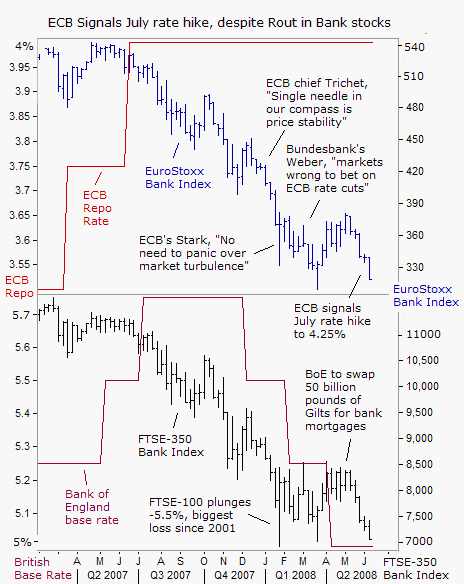
Finally, European central bankers couldn't hold back their deep frustration with the Bernanke Fed's delusional denial of commodity inflation any longer, and delivered their first bombshell in 12-months. “After carefully examining the situation, we could decide to move our rates a small amount in our next meeting, in order to secure the solid anchoring of inflation expectations,” warned ECB chief Jean “Tricky” Trichet on June 5th. “Anchoring inflation expectations” are the ECB's code words for a baby-step quarter-point rate hike to 4.25% in July.
Once again, “Tricky” Trichet managed to bamboozle market traders. “The ECB is not split, we have sent a clear message to the markets about what to expect in the near future. We have to let deeds follow words,” his sidekick Bundesbank chief Axel Weber said on June 5th. The ECB's shift towards a tighter money stance, ricocheted across the world, sending bond yields surging in England, Canada, Germany, and the US, while Japanese bonds plunged to their lowest in nine months.
Up until the ECB delivered its bombshell, the ECB was widely expected to follow in the footsteps of the Bank of England, the Bank of Canada, and the Fed, and slash its repo rate, to cushion the downfall of the European banking sector. So far, global banks have recognized $350 billion of losses from toxic sub-prime US mortgage debt, and the Swiss National Bank says the write-offs are only half-way over.
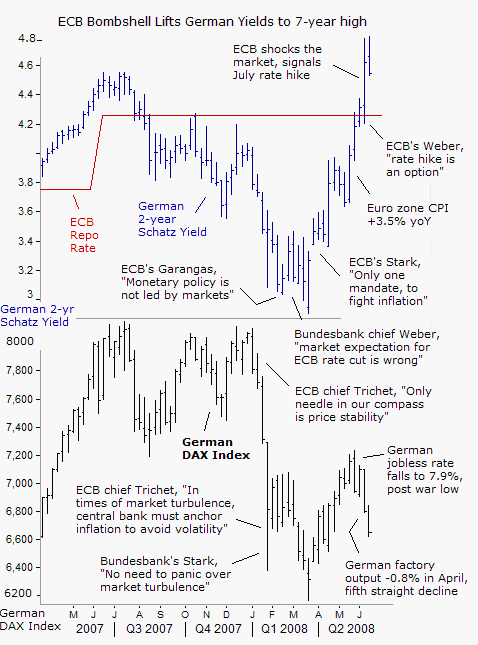
Taking aim at the easy-money clique within the “Group of Seven” cartel, Bundesbank chief Weber argued on June 6th, that “Central banks should not cut interest rates in order to help banks with their refinancing needs, but instead, should keep monetary policy focused on maintaining price stability,” he said. Italian central banker Mario Draghi said G-7 central banks should take some of the blame for the current inflation spiral, because of “monetary policies that favor excessive money and credit growth globally, with exceptionally low interest rates.”
The ECB stood steadfast in its battle of wits with German schatz traders, who had driven benchmark 2-year yields to as low as 3% in mid-March, betting on a series of three ECB repo rate cuts to 3.25%, to bail-out bludgeoned speculators in the Euro-zone stock markets. But the ECB refused to be bullied by schatz traders into an easier money policy, unlike other G-7 central bankers, who lost their nerve.
Back on Feb 1st, Greek central banker Nicholas Garganas said, “Our monetary policy is not led on what the markets expect. I'm very concerned about the high inflation rate. Inflation risks remain on the upside. If there's a risk that we'll not achieve our objective in the medium term, we'll act pre-emptively and decisively,” he warned. Yet the ECB waited for crude oil to soar above $125 /barrel, before signaling a baby-step rate hike, out of fear of sending the Euro through the roof.
German schatz traders were rocked by Trichet's bombshell last week, with 2-year yields soaring to as high as 4.80%, it's highest in 7-years. However, the highly leveraged and volatile markets tend to overshoot, when the herd mentality kicks-in, prompting Bundesbank hawk Juergen Stark to say the ECB is not planning a series of interest rate hikes, and knocking the 2-year German yield to 4.53% today.
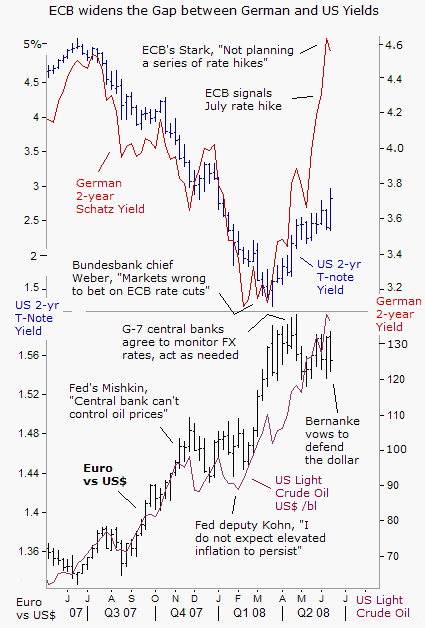
But when the dust began to settle down, it became clear, that the ECB was calling “Bernanke's Bluff” on defending the US dollar. Seizing upon Bernanke's vow to the Int'l Monetary Conference to defend the dollar, the ECB is now testing the true intentions of the Fed, by signaling a pre-emptive repo-rate hike to 4.25%, and widening the German interest rate advantage over the US Treasury yields.
The ECB's is building a reputation as a tough inflation fighter, while the Bernanke Fed's anti-inflation credibility has been badly mutilated, by the weak US dollar and the fireworks display in the commodities markets. It will take much more than a few sentences from Bernanke to undo this damage. However, the ECB is forcing the Bernanke Fed to stiffen its spine, and narrow the gap between higher yielding German notes, and lower yielding US T-notes, by lifting the fed funds rate, in order to make good on its pledge to defend the dollar.
In the past, European central bankers tended to follow the US Federal Reserve, on setting interest rates. This time however, while the Fed slashed rates 325 basis points, the Europeans refused to follow, and are now moving in the opposite direction with a baby-step rate hike. This suggests that in terms of global monetary policy, we're witnessing a historic shift in the balance of power, with the ECB now dictating policy to the Fed, another sign of America's loss of global hegemony.
The Bernanke Fed has contributed greatly to the surge in global inflation, by pegging the fed funds rate deep into negative territory, and neglecting the dollar's loss of value. The ECB's power-play to force the Fed into a partial reversal of its rate cuts, comes at a time when German factory orders have declined for five straight months, and carries the risk of weakening the European and global economy.
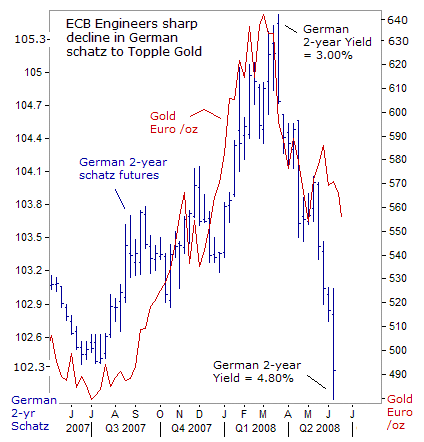
Adding to the tension, crude oil prices are perched above $125 /barrel, the tipping point that can derail the global economy into a wreck. Yet the alternative, a march into the abyss of hyper-inflation, could lead to an even greater turbulence and a economic depression. Taking the lead among the G-7 central banks in stopping the march towards hyper-inflation, the ECB has engineered a sharp decline in the German schatz market, to take the shine off the gold market, which has tumbled to 556-euros today, from a record high of 640-euros three months ago.
Whether the ECB can pull-off this magic trick, and prod Bernanke and his boss, Treasury chief Henry Paulson, into a series of Fed rate hikes to 2.75% this year remains to be seen. For now, the Fed is hoping that “jawboning” will do the job of containing the upward spiral in commodities, and support the dollar, giving it room to avoid raising interest rates as the economy sinks deeper into recession.
The Fed appears to be handcuffedby a weakening economy. The problem is, if Bernanke is bluffing about a tighter money policy to defend the dollar, it will open a Pandora's Box to even greater instability and volatility in global markets.
By Gary Dorsch,
Editor, Global Money Trends newsletter
http://www.sirchartsalot.com
To stay on top of volatile markets, subscribe to the Global Money Trends newsletter today, for insightful analysis and predictions for the (1) top stock markets around the world, (2) Commodities such as crude oil, copper, gold, silver, and related gold mining and oil company indexes (3) Foreign currencies (4) Libor interest rates, global bond markets and central bank monetary policies, and (5) Central banker "Jawboning" and Intervention techniques that move markets.
GMT filters important news and information into (1) bullet-point, easy to understand analysis, (2) featuring "Inter-Market Technical Analysis" that visually displays the dynamic inter-relationships between foreign currencies, commodities, interest rates and the stock markets from a dozen key countries around the world. Also included are (3) charts of key economic statistics of foreign countries that move markets.
Subscribers can also listen to bi-weekly Audio Broadcasts, with the latest news on global markets, and view our updated model portfolio for Q'1, 2008. To order a subscription to Global Money Trends, click on the hyperlink below, http://www.sirchartsalot.com/newsletters.php
Mr Dorsch worked on the trading floor of the Chicago Mercantile Exchange for nine years as the chief Financial Futures Analyst for three clearing firms, Oppenheimer Rouse Futures Inc, GH Miller and Company, and a commodity fund at the LNS Financial Group.
As a transactional broker for Charles Schwab's Global Investment Services department, Mr Dorsch handled thousands of customer trades in 45 stock exchanges around the world, including Australia, Canada, Japan, Hong Kong, the Euro zone, London, Toronto, South Africa, Mexico, and New Zealand, and Canadian oil trusts, ADR's and Exchange Traded Funds.
He wrote a weekly newsletter from 2000 thru September 2005 called, "Foreign Currency Trends" for Charles Schwab's Global Investment department, featuring inter-market technical analysis, to understand the dynamic inter-relationships between the foreign exchange, global bond and stock markets, and key industrial commodities.
Copyright © 2005-2008 SirChartsAlot, Inc. All rights reserved.
Disclaimer: SirChartsAlot.com's analysis and insights are based upon data gathered by it from various sources believed to be reliable, complete and accurate. However, no guarantee is made by SirChartsAlot.com as to the reliability, completeness and accuracy of the data so analyzed. SirChartsAlot.com is in the business of gathering information, analyzing it and disseminating the analysis for informational and educational purposes only. SirChartsAlot.com attempts to analyze trends, not make recommendations. All statements and expressions are the opinion of SirChartsAlot.com and are not meant to be investment advice or solicitation or recommendation to establish market positions. Our opinions are subject to change without notice. SirChartsAlot.com strongly advises readers to conduct thorough research relevant to decisions and verify facts from various independent sources.
Gary Dorsch Archive |
© 2005-2022 http://www.MarketOracle.co.uk - The Market Oracle is a FREE Daily Financial Markets Analysis & Forecasting online publication.


